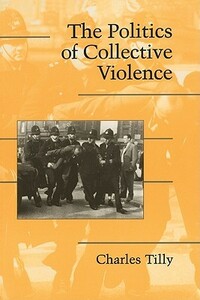Take a photo of a barcode or cover
a comprehensive analysis of collective violence in all its forms - a must read for scholars of violence.
Sociologist Charles Tilly attempts to categorize violence in societies of high/low capacity and democratic/undemocratic features across a spectrum of violent rituals(lynchings, public shaming, soccer hooligans), coordinated destruction (pogroms, genocide, purges), opportunism (looting, piracy), brawls (riots, bar fights, road rage), scattered attacks (sabotage, Luddites) and broken negotiations (protection rackets, extortion, threats), with vivid examples from historical accounts and contemporary conflicts. Tilly then suggests the points at which violence erupted because systems of control of boundaries broke down allowing people who previously had lived peacefully together to turn on one another.
Very repetitive book which contains some really good theories on why collective violence occurs.
In The Politics of Collective Violence, Charles Tilly, a historian and sociologist, aims to explain variations within collective violence, common cause-effect links within each type of collective violence, and how they transition from one variety into another. The focus is on underlying combinations of mechanisms and processes that cause routine non-violent interactions to turn violent and how, in-turn, they morph into different violent types. Tilly does not intend to define strict measurements and rules to be used to predict such events. Instead, he hopes to “develop new lines of explanation that apply across…times, places, groups, social settings, and forms of action."
Importantly, Tilly punctuates his sociological analysis of collective violence with a wide array of historical events. These illustrations include events ranging from Jamaican elections to brawling factions of French journeymen. The lively examples from around the world and throughout time bring to life the categorizations outlined early in the book. Such carefully picked examples work as evidence to reinforce his ideas. In one instance, when discussing coordinated violence, Tilly discusses violence in Ulster, Ireland. Using a Western, high capacity democratic regime demonstrates that destructive events are not unique to a particular culture, such as non-Western cultures, nor to only undemocratic, tyrannical regimes.
Despite the overall strength of his historical examples, a weakness emerges as well. Tilly states, “if forced to choose between a non-violent tyranny based on stark inequality and a rough-and-tumble democracy, I would choose the democracy." Readers should be aware of Tilly’s bias because, as a result, many examples skew towards pointing out the minimal damage of democratic regimes in contrast to petty, tyrannical undemocratic regimes. This issue could be addressed if Tilly discussed in more detail the commonly used violence within democratic regimes, such as “their external enemies as well as against excluded political actors and population categories within their jurisdictions."
The Politics of Collective Violence is an essential contribution to understanding processes underling collective violence in a variety of political atmospheres. The book successfully explains variations and transitions within and between the typologies of collective violence. Tilly backs up his work with an assortment of statistical and historical work. The minor bias towards democratic regimes does not detract from Tilly's excellent explanations and collective violence examples. His clear writing easily breaks down the complex mechanisms and processes underlying collective violence, which allows for readers previously unaware of the topic to understand the topic.
Importantly, Tilly punctuates his sociological analysis of collective violence with a wide array of historical events. These illustrations include events ranging from Jamaican elections to brawling factions of French journeymen. The lively examples from around the world and throughout time bring to life the categorizations outlined early in the book. Such carefully picked examples work as evidence to reinforce his ideas. In one instance, when discussing coordinated violence, Tilly discusses violence in Ulster, Ireland. Using a Western, high capacity democratic regime demonstrates that destructive events are not unique to a particular culture, such as non-Western cultures, nor to only undemocratic, tyrannical regimes.
Despite the overall strength of his historical examples, a weakness emerges as well. Tilly states, “if forced to choose between a non-violent tyranny based on stark inequality and a rough-and-tumble democracy, I would choose the democracy." Readers should be aware of Tilly’s bias because, as a result, many examples skew towards pointing out the minimal damage of democratic regimes in contrast to petty, tyrannical undemocratic regimes. This issue could be addressed if Tilly discussed in more detail the commonly used violence within democratic regimes, such as “their external enemies as well as against excluded political actors and population categories within their jurisdictions."
The Politics of Collective Violence is an essential contribution to understanding processes underling collective violence in a variety of political atmospheres. The book successfully explains variations and transitions within and between the typologies of collective violence. Tilly backs up his work with an assortment of statistical and historical work. The minor bias towards democratic regimes does not detract from Tilly's excellent explanations and collective violence examples. His clear writing easily breaks down the complex mechanisms and processes underlying collective violence, which allows for readers previously unaware of the topic to understand the topic.


